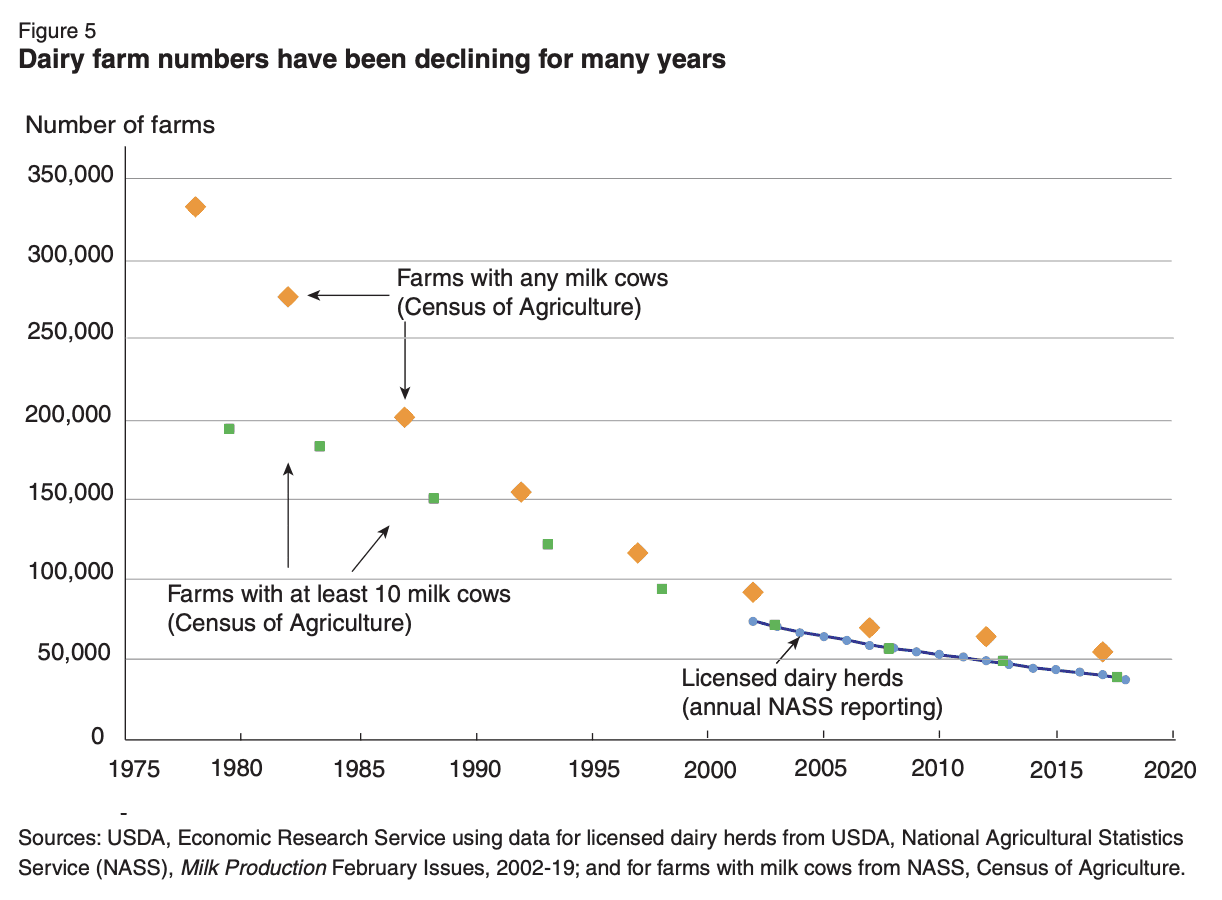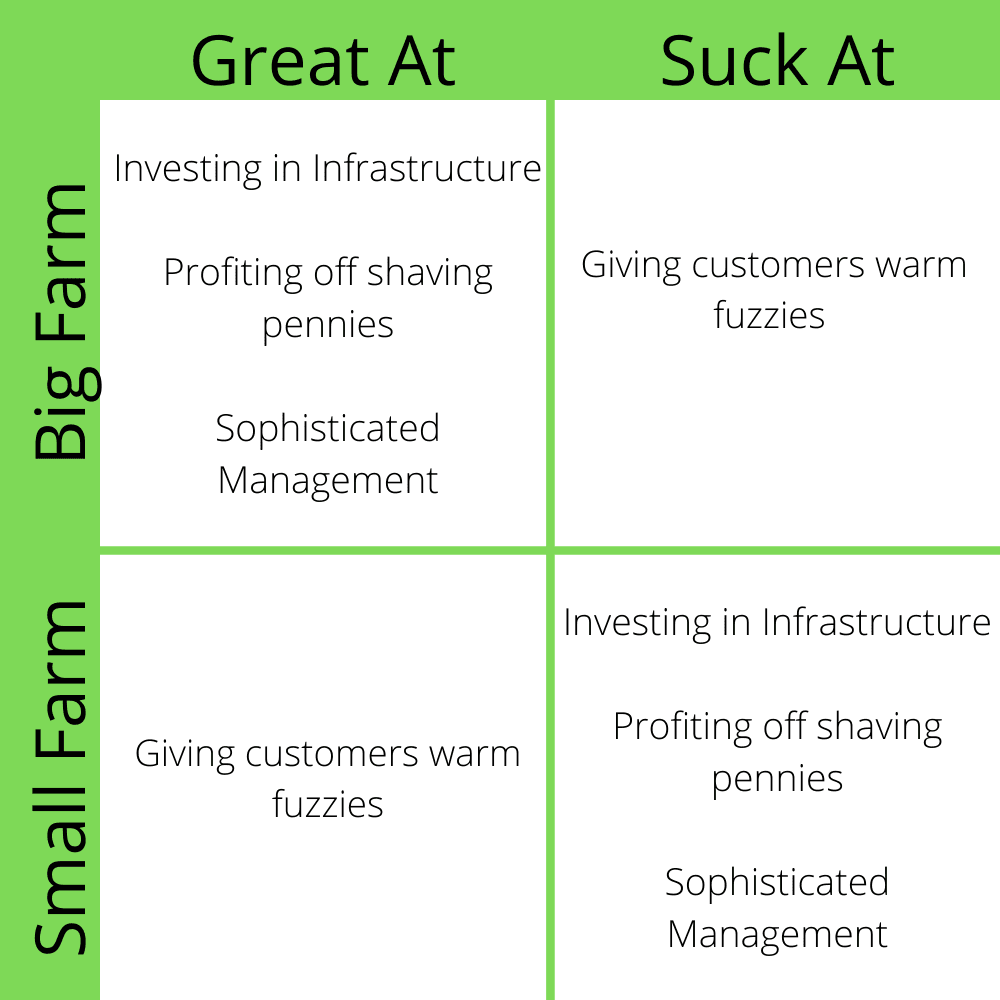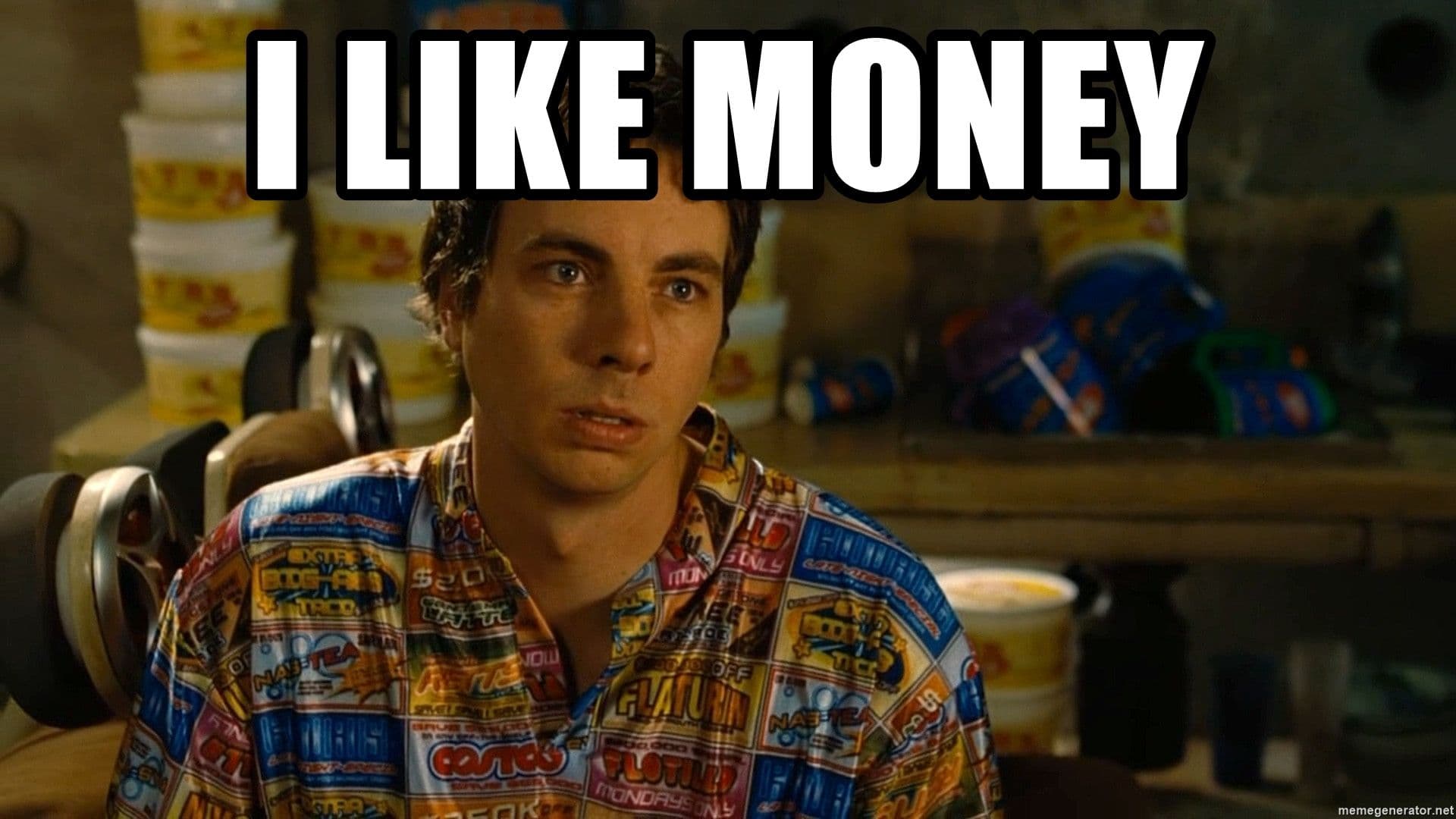What will farming look like in 2050?
Let's take a look back and pretend history tells the future.
I'm pretty sure if you where sitting at the USDA in 1990 you could have done a fair job of guessing how many dairy farms would exist in 2020. You definitely wouldn't have got the direction wrong.
Farms get bigger at a rate faster than the consumption pie expands and so we have fewer total farms over time.
A good rule of thumb I'm stealing / bastardizing from the USDA is that every 30 years farm numbers in dairy reduce by 3/4.

31,657 dairy farms in USA in 2020 turns into 7,914 dairy farms in 2050.
If we add some pressure from alt protein, technology acceleration, and aging farmers no reason this couldn't be more like 5,000 or even 1,000 farms. How do you define a farm anyway?
Dairy is the example I use because it's easiest for me to find charts but the same idea works for every commodified agricultural good in modern markets.
The future of agriculture is large farms producing commodities and small farms creating value added products.
This is the farm barbell.
This is the bifurcation of the supply chain into two primary buckets, big and small, with few exceptions. Scale profits and specialized profits.
I don't think I have declared something radical.
I might have even wasted most your time up till this point.
I'm just writing down what is the what most producers see as the future as far as I can tell.
"Get big or get out" coupled with "Niches make riches".
The interesting part comes when we talk about what that means for what companies should be built to take advantage and solve problems for this future.
How should farms invest their margin?
What products should companies build for each segment?
How do we find the elusive "lightning in a bottle" product market fit? ( never done it so maybe I shouldn't comment? )
I think one easy way to approach this is to think about how each segment makes money and which of those activities they can't easily do for themselves.
If you weren't trying to be crazy sophisticated it might look like this.

Given this as a baseline what can companies build that farms actually want?
My impression is that for large farms you build more of the same of what has been the bread and butter for the western agtech stack.
Management tools Biological improvements Risk management / hedging / crop marketing Scaled mechanization Input / Output optimization in general The key to most of these products is the opportunity to create 10x ROI products that fit into how large farms work.
If you can predictably save a farm $0.01 per gallon of milk produced with your cool new technology this can generate $339k dollars of savings per year for a dairy with 10,000 cows.
(( 10,000 cows x 365 days x 80lbs ) / 8.6lbs per gallon ) * 0.01 = $339k
Saving hundreds of thousands of dollars is attractive for most people.
So you can charge $33k per year in products and services to this farm and have a verifiable 10x ROI and a win win.
Perhaps in 2050 there are about 1k farms with 10k head per farm which equals a US dairy herd of 10m or about the size of the current herd.
1K customers @ $33k rev / customer / yr = $33m annual revenue from USA market domination by shaving $0.01 off the farmers gallon.
And what if you saved them $0.03? $0.05?
If you can charge $150k per year instead @ $0.05 savings * 1,000 customers with a SaaS revenue valuation multiple @ 10x?
You get the idea. I like rocket ship napkin math.
Helping scale businesses shave pennies makes a lot of happy people and creates a lot of value.
This company would be a good company as long as what it was selling was real and believed.
The products it creates would be valuable and wanted by farms.
** but this only works for and is interesting for large operations **
The other side of the barbell doesn't and shouldn't really give a shit if you save them a penny.
Coupons don't solve poverty.
Revenue does.
If you save an operator with 100 cows $0.01 per gallon you saved them $3,395.
(( 100 cows x 365 days x 80lbs ) / 8.6lbs per gallon ) * 0.01 = $3,395
Can you provide this product for $339 per year?
Will the $3k savings be big enough to the farmer for you to sell it or is it reliable enough to even be believed?
$3k is one broken part on a tractor. One random bad day in the farmers mind.
This product doesn't fundamentally make enough upside to be crazy successful for buyers or sellers.
The products that are interesting for scaled farms are not interesting for small farms.
So what do you build for small farms?
Let's start with the expectation that small farms will exist due to demand for luxury and local persisting near urban centers gripped with red barn romanticism.
Small but specialized operations situated on expensive land nearish urban centers predominantly.
Almost everything the large operator excels at this small operator finds fundamentally difficult.
They don't have the scale to borrow lots of money to invest in infrastructure.
They don't have the money to pay whole teams to manage capital structures, land deals, marketing, procurement or procedure.
They can't get to any interesting future by reducing costs.
For small farms increasing margin capture and revenue growth is basically the only exciting game to play.
So what to build?
This whole space to me feels like the origins of cloud infrastructure.
One of the key unlocks to the cambrian explosion of internet startups today was the rise of "Infrastructure as a Service" (IaaS) via the cloud.
This is creating bite sized, rentable infrastructure that can be composed into systems that have fundamental abilities closer to big companies but are approachable to small companies.
Low barriers to entry. Low switching costs. High experimentation. For small farms the main categories roughly would be logistics, processing, and marketing.
Ad-hoc route trucks to take animals to slaughter or products to market is the precursor to a logistics network.
The market pull from ranchers trying to build more smaller meat packing plants is the search for the processing.
Farmers markets are an early aggregation layer to assist in marketing.
Rebuilding the existing infrastructure of food to create low barriers to entry options for food producers is how you create margin capture for farms and interesting business to serve them.
I like to call these products the AWS of Food.
To give an example of why this builds interesting futures for farms and companies that serve them let's play the same game as before.
What if you had logistics, processing, and marketing available as a service and helped a dairy go upmarket?
Let's get that same 100 cow dairy into butter.
This is the status quo for the farm in question.
(( 100 cows x 365 days x 80lbs ) / 100 cwt ) * $20 milk / cwt = $584k annual revenue.
It takes 21 lbs of milk to make 1 lbs of butter.
Let's say the target is to get 10% of the farms milk upmarket via butter in the first year via IaaS.
(( 100 cows x 365 days x 80lbs) * 10% ) / 21 lbs = 13,904 lbs of butter / yr produced.
Remember we are going expensive. $1 / oz retail price.
We are targeting bougie keto software developers.
13,904 lbs _ ($1/ounce _ 16 ) = $222,464 butter revenue
What can we charge this farmer to get a 10x return and a win win?
Perhaps in this scenario it's not strictly about 10x but what is an outcome that would be both interesting for the farmer and the IaaS provider?
The farmer bet 10% of the milk revenue so we start by subtracting $58k from annual milk revenue of $584k
$584k milk rev - $58k milk value into butter = $526k
$526k commodity milk revenue + $222k butter revenue = $748k total revenue.
How much would this farm be willing to pay for this future?
Especially if there was almost no fundamental change to the day to day operations on the farm other than a few extra meetings and a media team with cameras stoping in on occasion?
I bet you could charge half.
$526k milk rev + $222k butter rev - $111k IaaS = $637k Annual Revenue year one.
By betting only 10% of the milk two full time people could have secured good incomes and are set up for a bright future.
Small farms like making hundreds of thousands of dollars as much as large farms like saving hundreds of thousands of dollars.
No version of cost savings could have made an interesting future like this for a small farm.
So thats really the whole idea.
The start of an idea. pic.twitter.com/3GPAyc8RxM
— carllippert (@carllippert) May 26, 2021
This is how to build an interesting future for both.
Go build stuff!
DM me on twitter if you think I'm full of shit. Thats called learning if you're right and I'm wrong.
Notes & Stuff
Large farms can play the niche game. The key is that they don't need a lot of help doing it. They can prop up facilities, hire specialist etc and they should if they want too.
Scale + Margin capture = "Fuck you" money.
If the evolution of AWS of Food or IaaS for Ag follows patterns from general business IaaS providers who create value for small companies initially can eventually become large service providers for large operations also. New co's adopt cloud early, old co's adopt cloud slowly.
IaaS birthed out of Amazon which was large co externalizing its internal systems is less likely to happen in agriculture given the realities of scale efficiencies in data centers having the concept of scaling via containerization vs scaling a milk plant is more similar to monoliths or horizontal scaling. Also think there are many cultural blocks for old food co's to provide services to small co's. Hard to punch down without benefit of purely digital fundamentals of scaling.
Black swans?
Yes. You cannot see or predict black swans but it's still fun.
If unit economics pan out for synthetic milk or meat, both products of the dairy industry, we could see the future being the only farms with cows being the smallest as "heirloom milk and meat" become a luxury good only for rich zealots. Do the large milk and cheese companies integrate with the large dairies before this inflection and become major synthetic producers or not determines who gets rekt and how. They know how to use trucks and stainless steel to feed people so they actually could be good at this with right attitude.
Some sort of green new deal could really fuck this up for the USA. IaaS would pop off like crazy if we artificially constrained individual site size for farm operations due to the need to externalize scale economies somewhere other than at the cow level. Another part of that unexpected future would be the migration of large herds to other jurisdictions. Mexico, Brazil, Argentina, idk places not here. This would be us exporting our responsibility for our protein supply chain because of moral biases rained down from above and serve no fundamental global improvement afaik.
Questions I am asking myself.
How does this relate to web3? Should providers be franchises?
If AWS is getting disrupted by web3 IaaS over time could we build the AWS of Food in a decentralized manor? How is that different to what exists? What incentive structures would need to be created to do that? Blockchains, DAO's, Franchises, Coops, Unions, Networks, Platforms. They all are flavors of the same theme of organizing people and capital in ways with improved fundamentals and aligned incentives.
Are route trucks the AWS S3 of IaaS for food and ag? The simplest building block that all people need?
